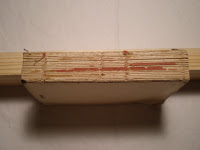Camp Sheridan
Montgomery Ala
Father Lange
KC Chaplain
The restored Bible measures 4 1/2" X 3 " X 3/4" and it has now full-leather covers in orange-brown pigskin, additional blank pages were added to the front and back of the text block, the spine was reinforced with Japanese rice paper and hinged with cloth; book ends were also added to the head and tail of the spine.
Special thanks to Chris Kading who has taught me many restoration techniques throughout the years.


































